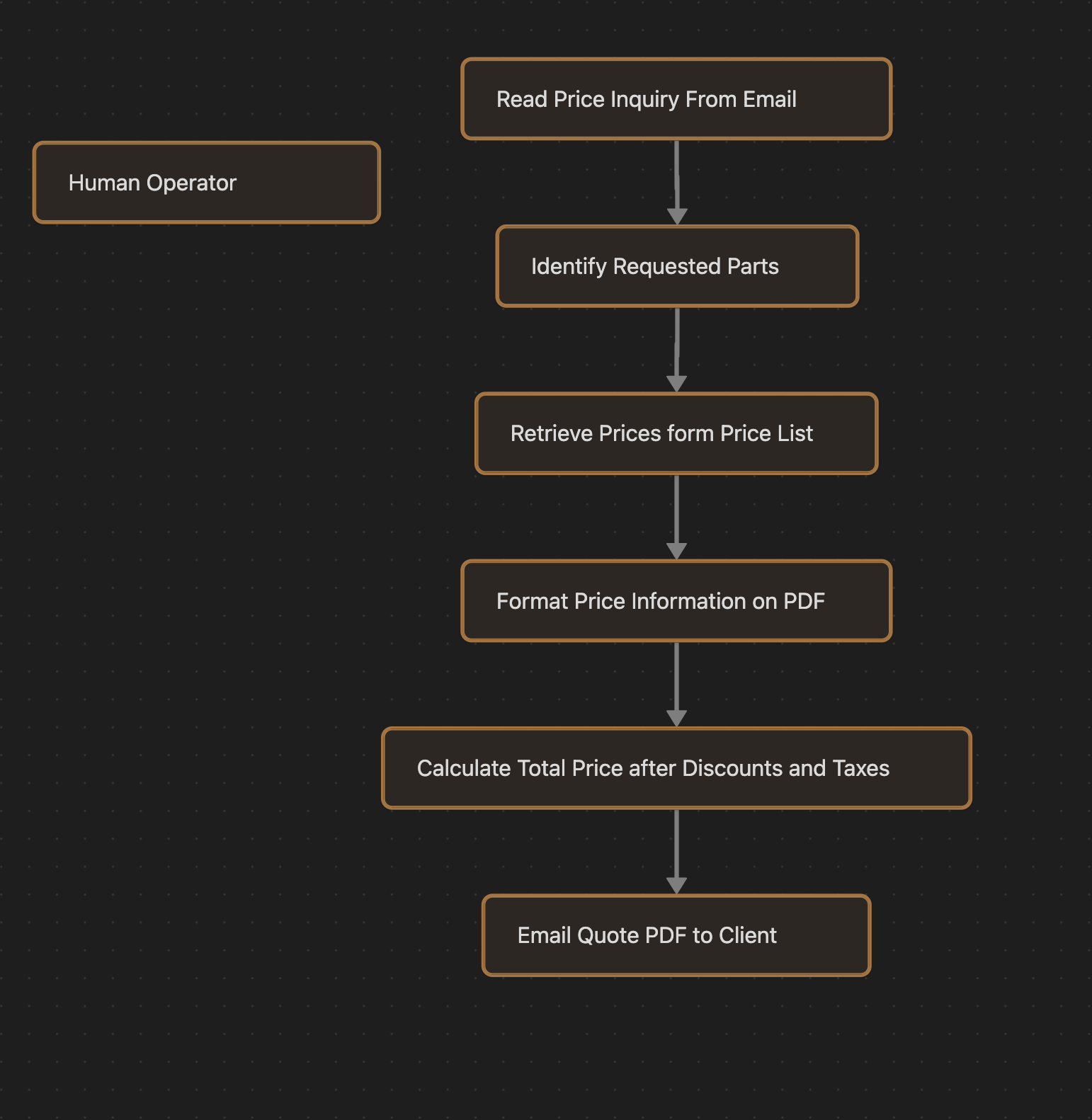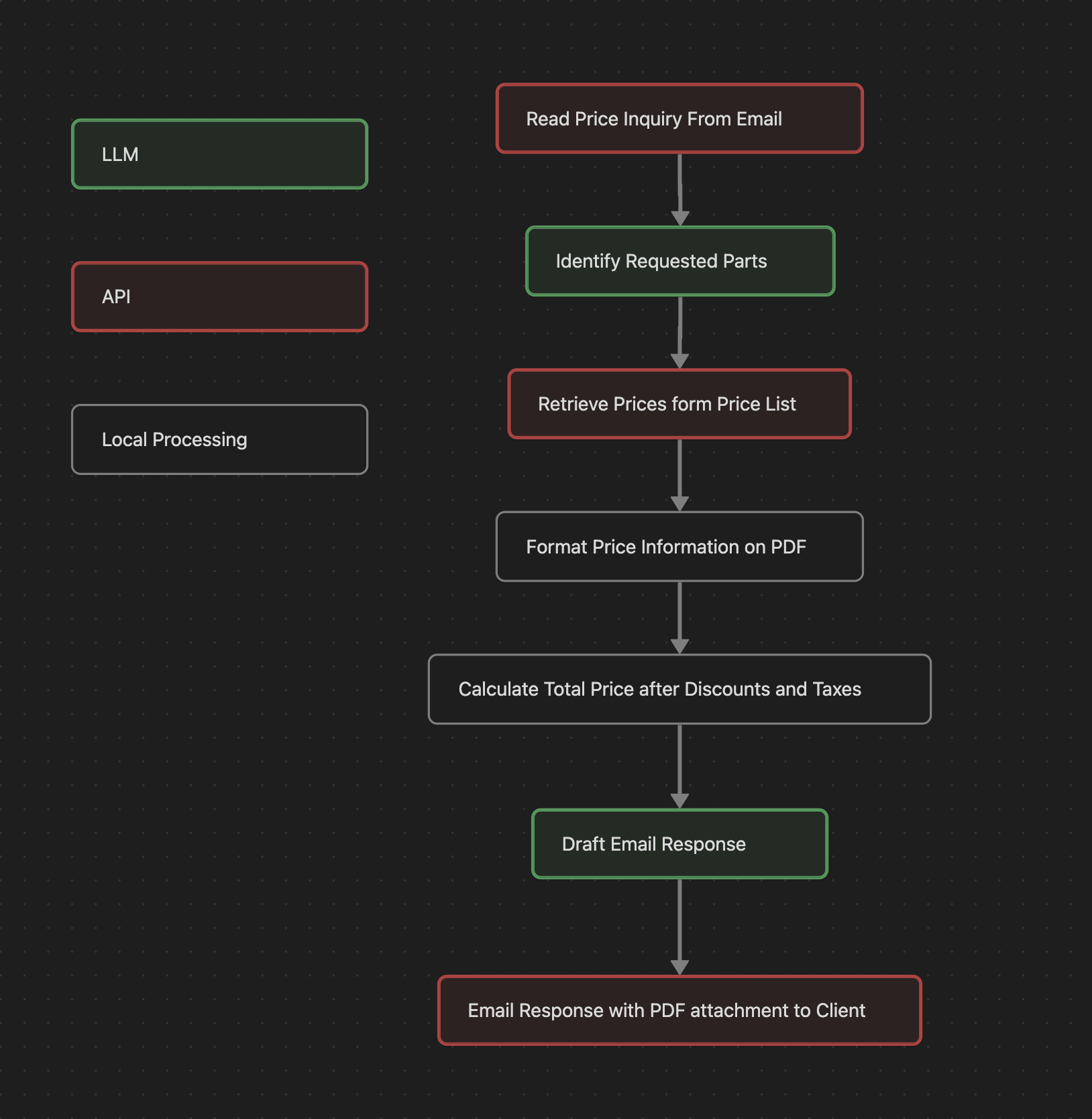- Published on
Cutting Costs with AI Powered Automation - A Case Study
- Authors

- Name
- Vaut
- @V_aut_

Email serves as the primary method of communication in the business world. It is the channel through which enterprises exchange crucial information, from external sales communications to internal requests for information, authorization and data processing. \ Despite the emergence of less formal business messaging platforms like Slack and Microsoft Teams, email reigns supreme as the universal interface for colleagues to get things done.
Now, picture this. You are working in an entry-level position at a fully remote company, carrying out most of your work asynchronously. You get your instructions in written format and return your work via an email with attachments.
You'd save enormous amounts of time by letting a virtual machine on the cloud listen to requests in your email inbox, interpret the instructions, carry out the necessary information processing, format the work and respond to the request via email.
All it requires are the necessary data access permissions and a sufficiently large training set of your past work.
Seems doable, no?
Case Study: A sales quote agent.
I recently started working with Zentratec to try and help the small team of the machinery distributor scale up their operational throughput.
An obvious bottleneck in their process was their sales quote creation in response to client price inquiries. Their process would involve reading through the inquiry, identifying the relevant machine parts, retrieving the prices from the price list, formatting the individual product quotes in a PDF and adding the total order price after discount and taxes.
This was a full time job at the company as each quote would take between 20 to 30 minutes per pricing request. The response was then returned as a PDF to the client.

The entire price quoting pipeline was operated by a human operator.
Today, this is what the pipeline running on the cloud 24/7 looks like:

First, an always-on large language model (LLM) is used as a means to interpret instructions received via email. A range of local and API functions are then triggered for information retrieval and processing in accordance with the email request. Finally, an LLM drafts an appropriate response that is sent to the client.
To be fair, the company had pretty much missed the first wave of digital automation, leaving the quote process filled with low-hanging fruit to be automated.
I focused on building as much of the pipeline without LLMs in order to minimize API costs, but would not be surprised if I start using them more and more as open-source initiatives bring down the price. \ That said, this pretty straightforward automated pipeline was running in production within a week, getting the job done in under 2 minutes and saving the company upwards of 95% of time and cost for operating the same business function.
Absolutely insane.
The Future of Work
The sales quote agent serves as an illustrative example of the potential for white collar automation that LLMs hold. How are you be able to tell if your asynchronous "colleagues" are not just mostly automated email agents that only show face during screen recordings and meetings? You can't really guarantee that anymore...
It is still early days in the journey of automated work pipelines serving as AI Agents. There will be the need to resolve bugs and quirks to build agents that perform on par with humans >99.99% of the time - but we will likely get there sooner than later.
The disruption of traditional business function over next 5 years will be enormous. The ventures that are first to adopt the use of commoditized intelligence are going to vastly outcompete teams without AI tools.
The biggest challenge for developers of AI Agents will be integrating machine intelligence as seamlessly as possible into current business function.
Microsoft is taking a brilliant approach by incorporating a CoPilot into all aspects of their Microsoft Office suite, enabling ChatGPT style information retrieval and generation within the company ecosystem.
Still, this agent will be constraint to the Microsoft suite.
Email on the other hand allows for communication through natural language with both, humans and LLMs, internal and external to the company or technology ecosystem. \

The potential of integrating AI Agents in the email enabled business functions is enormous for three reasons:
- It is the communication interface that spans everybody in todays work force. Everyone from gen z to boomers is already comfortably onboarded to the email communication protocol - right now.
- Business functions are already up and running with email as industry agnostic means of communication. There is no friction in integrating email-first AI agents into current business processes as they already exist today.
- Leveraging email as communication interface outsources the problem of UI design and maintenance to email providers such as Gmail and Microsoft Outlook, eliminating a whole vertical of development headaches.

The recent rise in asynchronous company operation leaves ample opportunity for workers to integrate commoditized intelligence to have the same impact on the company for a fraction of the time. Or even better, 10x their work output while working the same hours.
If you are receiving work instructions and returning your labor in written format, there is ample promise in using LLMs with custom functions to increase your leverage through computation.
Make sure to keep an eye on the developments in the AI Agent space - you really don't want to miss the train on this one.